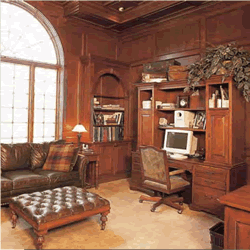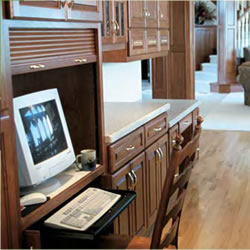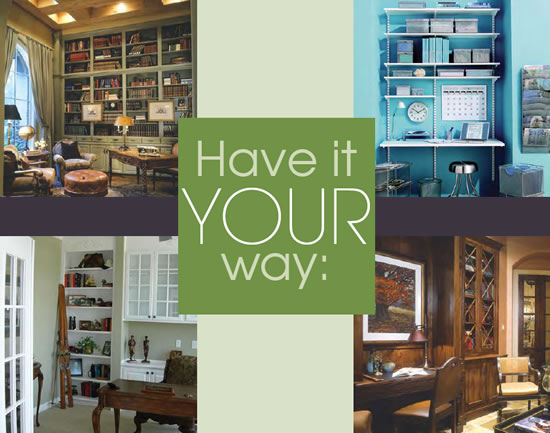CREATING A HOME OFFICE THAT IS RIGHT FOR YOU
It’s no wonder millions of Americans are now working from home. Unlike a commercial office, a home office can reflect your personality, likes and dislikes. Having a completely individualized work space can make the difference between having to work and wanting to work. In fact, after moving home, you may find yourself staying at your desk a little longer – which balances out time-wise since there’s no commuting!
THE IDEAL LOCATION
Individual needs play a large part in determining a home office’s location. Each possible location has pros and cons to consider. If you will be meeting with clients, an office near an exterior entry and a bath will allow the rest of the family to retain some degree of privacy. Many new homes include an office off the front entry, enclosed by stylish, glass French doors. However, such a public location may be undesirable if your work habits are less than tidy.
If you prefer a sense of community or need to keep a loose watch on children, you may prefer a loft overlooking the great room. However, even if you can tune out the distractions inherent to an open loft, you’ll want to ensure clients on the other end of the phone don ’t hear children roughhousing in the background.
If, on the other hand, you function best in a quiet, secluded spot, you might choose to locate your office in the basement, the attic, your master suite or a finished room over the garage.
Utilizing a sitting area off your master bedroom may interfere with your partner ’s sleep if you like to work at night – or interfere with yours when a difficult project remains in your field of vision. To provide visual separation, a bookcase on a track can close off the bedroom.
 A converted spare bedroom offers natural light and a closet for storage. However, it ’s important to consider resale before making a bedroom a permanent office. According to a study by the National Association of Realtors, listing a “professional home office ” on real-estate ads subtracted an average of 5% from the selling price, while mentioning a “den/study” added 7% to the selling price.A converted spare bedroom offers natural light and a closet for storage. However, it ’s important to consider resale before making a bedroom a permanent office. According to a study by the National Association of Realtors, listing a “professional home office ” on real-estate ads subtracted an average of 5% from the selling price, while mentioning a “den/study” added 7% to the selling price.
A converted spare bedroom offers natural light and a closet for storage. However, it ’s important to consider resale before making a bedroom a permanent office. According to a study by the National Association of Realtors, listing a “professional home office ” on real-estate ads subtracted an average of 5% from the selling price, while mentioning a “den/study” added 7% to the selling price.A converted spare bedroom offers natural light and a closet for storage. However, it ’s important to consider resale before making a bedroom a permanent office. According to a study by the National Association of Realtors, listing a “professional home office ” on real-estate ads subtracted an average of 5% from the selling price, while mentioning a “den/study” added 7% to the selling price.
If your home has three or four other bedrooms, a permanent office probably won ’t hurt resale. If not, it ’s wise to keep the room flexible by not changing window and door configurations or covering walls with permanent cabinets or shelving. If you ’re building a home with fewer bedrooms, it ’s wise to include a closet so the room can easily convert back to a bedroom for future homeowners.
With their sloped ceilings and interesting nooks, attics offer charm and isolation. “On the down side, vent stacks and low ceilings may limit how the space is used, ” notes Design Basics Custom Home Designer Carl Cuozzo. “Most building codes require that at least 50% of the floor area have a ceiling height of 7 feet, 6 inches. In addition to installing wiring and ductwork, finishing an attic space may require structural changes to strengthen the floor and adding insulation to keep the space cool in the summer.”
Offices over garages often have cold floors. To eliminate this problem, ensure the floor is very well-insulated and consider installing electric radiant heating grids.
While naturally cool in the summer, basement offices often require a dehumidifier to control dampness and adequate insulation to be comfortable in cooler months in northern climates.
Basement offices may have small or no windows. While somewhat expensive, this can be remedied by installing a window well. If a low ceiling makes the space feel claustrophobic, consider painting the walls and ceiling in monotones (with the lightest tone on the ceiling), applying a satin paint on the ceiling, using uplighting, incorporating vertical stripes on the walls or installing tall, thin bookcases.
REDUCING NOISE
Noise coming in or going out of the office can be a concern. You may not want your office next to the great room if your husband likes to crank up the volume when he watches movies. If you’re particularly sensitive, you may be distracted by the dishwasher, washing machine or furnace as well. Rooms that don’t face the street will generally be quieter than those that do. On the other hand, frequent phone calls, a fax machine and a printer may disturb the serenity of neighboring rooms.
Drapes and carpeting will help absorb sound. (Flat pile floor coverings produce less static and are easier to roll an office chair over.) Adding bookcases filled with books or turning an entire wall into a bulletin board by installing cork can also help.
“Other possibilities include adding two layers of dry wall or sound channels (corrugated rubber behind the dry wall) in interior walls and installing a threshold in the doorway with a solid, tight-fitting door and a weatherproof sweep on the bottom, ” advises Cuozzo. “If the room is highly insulated from the rest of the house, it may be wise for it to have its own thermostat. It ’s also important to remember that it ’s easier to keep sound in than to keep it out. So it will be most effective to insulate a space where the noise originates.”
LIGHTING AND WIRING
Even with wireless networks, home offices require ample outlets, conveniently located. If you ’re planning to have a desk away from the walls, you may want to consider having an outlet installed in the floor to eliminate stepping over cords. Some sources also recommend isolating the office on its own circuit to avoid tripping a circuit breaker.
A variety of light sources on separate switches will provide choices for different tasks. Because glare on white paper and computer screens can produce eye strain, indirect light is a welcome option.
Avoid having a computer screen face a window. The best position for a computer is at right angles to a window so that light falls on the working area but doesn’t reflect off a screen. Blinds are a good window covering because they allow you to direct the light to the ceiling to create a soft, ambient light. Indirect lighting hidden in moldings will produce a similar effect. Accent lighting on decorative objects can add drama, and task lighting is important for reading printed matter.
LIMITED SPACE

When not in use, this small kitchen workspace is neatly hidden in special cabinets.When not in use, this small kitchen workspace is neatly hidden in special cabinets.
In homes that don’t have the luxury of a designated office, creative homeowners may“ find ” a suitable spot in a wide hallway, stair landing, recessed space under a staircase, walk-in closet or butler’s pantry. Even a reach-in closet can accommodate a desk with shallow shelves above it.
The other solution is to share space in a room that serves another function. One possibility might be to add a stylish desk to one end of a great room. For added privacy, you may purchase a folding screen or create a room divider camouflaged as a bookcase.
A computer armoire in a dining room can also work quite well. Dining rooms aren’t used on an everyday basis; they provide an attractive place for an occasional meeting with clients; and the table offers a large work surface.
Because they’re used infrequently, guest rooms also often double as offices. A built-in wall unit can include office storage, a pull-down desk and a Murphy bed. On a smaller scale, a deep drawer under a captain’s bed can be fitted with hanging files, a roll-top desk can keep projects out of sight or a computer on a trolley can be wheeled into another room before guests arrive.
CONFIGURATIONS
The L, T and U work space designs mentioned in “Hobby Rooms: Creative Getaway Spaces” (page 18) are also common in offices. The most popular of the three, the L shape does not have to be anchored to a wall and can float in a large room. A T shape can work well for two people sharing an office.
An ideal work space is around 60 inches wide and 32 inches deep, offering space for a monitor and free space for hand writing or reading. According to Lorrie Mack, author of Calm Working Spaces, you should also allow at least three feet clearance between your chair and a wall or other furniture, a minimum of 24 inches between other furnishings and three feet or more in front of a filing cabinet.
LEGAL MATTERSBefore proceeding, it’s important to ensure local zoning ordinances do not prohibit or restrict the home office you envision. This may be more likely if you will be receiving regular deliveries, clients will be coming to your home or you will be employing additional help. You should also review your homeowner’s insurance policy to make sure you will be adequately covered.
On the plus side, if your home office will be your primary place of business, you may be able to deduct your equipment and furnishings, the cost of decorating the office and even a percentage of your home’s utility cost on your income taxes. By the same token, a designated office used only for business might attract a capital gains tax when you sell your home, according to Mack. She suggests this can often be avoided if the room has another household function (such as a guest room).
If there are no legal restrictions, it may be time to leave that gray cubicle and head home!


